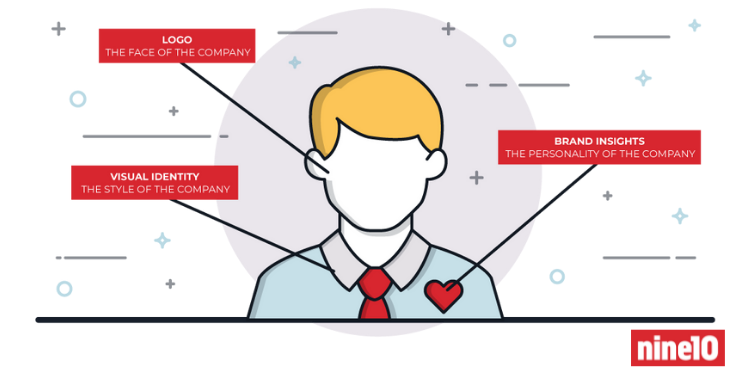This article was provided to us by our friends at nine10.
You hear these terms thrown around all the time, yet you aren’t confident in how to tell them apart. You’re not even sure that the people who use them know what they mean. Luckily, here’s one simple metaphor to help you understand the difference, once and for all.
The three terms logo, identity, and brand insights are often used interchangeably. The first thing you need to know is that they should be understood on a spectrum. A logo is a small (yet important) piece of your business, a brand entirely surrounds your business, and identity falls somewhere in the middle.
Think of Your Company as a Person
We typically recognize other people in three ways: from a face, a style, or a personality. Think of a company’s logo, visual identity, and brand insights in the same terms: a logo like a face, an identity like a style, and brand insights like a personality.
Logo: The Face of the Company
A face helps us recognize the people around us, especially those who we haven’t got to know (like that one person you keep seeing around town but have never actually met). A logo serves the same purpose — it’s the face of a company that customers will recognize, even if they’ve never interacted with the company themselves. Twitter uses a little bluebird, McDonald’s has the golden arches, and Starbucks uses a green and white siren. We recognize them by their logos.
What Makes a Logo Great:
- Uniqueness – A creative logo will stand out from the rest.
- Meaningful – A good logo should be dripping in meaning and possibly include implicit or explicit metaphors.
- Reproducible – A logo should have the ability to be used on different mediums easily and consistently.
At nine10, we put a lot of attention to detail when it comes to logos. Since a logo is like the face of a company, it should reflect the values and purpose of the company through thoughtful, deliberate design. Check out our portfolio for some of the ways that we’ve infused hidden (and not so hidden) meanings into our client’s logos.
Visual Identity: The Visual Style of the Company
Let’s say a friend of yours walks into a room, and you can tell it’s them even though you didn’t see their face. Their style, the way they dress, their walk, all of that gave them away.
A business’s visual identity is kind of like its style, which can be recognized even without a logo. The visual identity can include everything from the fonts, colours, and imagery, to design elements and even photography styles that a business uses all contribute to its identity. Telus Corporation uses a white background and cute animals to advertise its services. When you’re watching commercials and the TV screen goes white with a hippo slowly waddling in, we know it’s going to finish with a Telus logo, even though you haven’t seen it yet.
A company’s identity doesn’t have to be only visual. You may have noticed that certain clothing stores use perfumes to scent their shop. The scent becomes familiar with the business, forming part of the business’s identity. Or, you’ll probably be able to recall a jingle on the radio advertising good pizza. The jingle is an auditory piece of the company’s identity.
What Makes a Great Identity:
- Consistency – A company that’s constantly changing fonts, colours, and style throughout their business seems unorganized and will be less memorable.
- Builds on the logo – An identity and logo should complement each other.
- Originality – A great visual identity that is too similar to your competition will only help to confuse your audience.
A great logo doesn’t necessarily mean a strong visual identity is in tow. Creating a visual identity is a project of its own, requiring its own design, plan, and implementation. Oliver’s Funeral Home is an excellent example of developing visual identities, completed by yours truly.
Brand Insights: The Personality of the Company
Every company has human-like characteristics. An athletic wear store might come off as bold, energetic, and daring through its social media, employees, and marketing. On the other hand, a maternity clothing store will probably seem a bit more calm, inspirational, and caring. Both businesses are clothing stores, yet have completely different personalities. They’re able to achieve this through their brand.
Brand insights encompass the values and attitudes at a company’s core. It’s not just the professional front that a business puts on — it’s the attitude of its staff, the tone of voice it uses, the level of energy, and ultimately the traits you’d consider personality characteristics.
Since brand insights really depend on how the world sees the company, it makes it difficult to control. In some cases, brand insights can even affect a business negatively. You’ve probably at some point in your life thought of a company as selfish, inauthentic, etc. Just like a person with a memorable face, a wonderful style, and a crabby personality; the ultimate judgment will be informed mostly by the less than desirable personality. The way that the company manages itself can raise a red flag in your mind, resulting in a negative brand. Fortunately, there are ways of preventing this.
 What Goes Into Effective Brand Insights:
What Goes Into Effective Brand Insights:
- Authenticity – When shaping brand insights, it’s important to build on the real strengths and passions of your business.
- Relatability – Your company personality should be relatable and complementary to your target audience.
- Consistency – You may have noticed we like consistency. That’s because consistency can make or break a brand.
At the end of the day, it’s your brand insights that will leave a lasting impression on your customer. There are plenty of businesses that have an outdated logo and a disorganized identity, yet are thriving due to their genuine personality. In these situations, the customers likely feel benefited and valued by the company: a defining emotional connection keeps customers coming back. Though it may be the toughest to tackle, we believe that a good brand adds tremendous value to a business.
How to Keep it Consistent
A branding standards guide helps to define all of the elements of logo, visual identity, and brand, and it develops a set of standards/rules for everyone to follow. These guides are used internally by owners, managers, and staff, as well as external partners such as the company’s various vendors.
Anyone can attempt to tackle these three branding components, but it takes skill to put them together in a way that builds from one to the other. When we build your Brand here at nine10, a branding standards guide is our best friend. Like it sounds, the guide is a physical document that lists all the dos and don’ts within your company’s brand. In addition to the guidelines, we hand over the master files of your logo, visual elements, fonts, and design templates, making it easy to follow the brand standards guide.
Does your business have a thriving identity and brand? Let’s find out, it’s as easy as a complimentary consultation. Head over to our Branding Services page to book in with our Business Development Strategist to see how we can help you.
Other ways we can help
- Resources for small business owners
- Connect with a small business strategist
- Upcoming events and webinars
About the author: nine10
Nine10 Incorporated has spent the last 16 years developing brands, websites, and training businesses across Alberta. After their merger with imageDESIGN, they now have a combined market experience of 38 years.
Change has always been a core value of nine10 and, as the world has changed and evolved over the last 16 years, nine10 has adapted their offerings to best service their clients. They focus on making sure their clients leave with the tools and confidence they need to manage their Brands, Websites, and Digital Marketing on their own.
With their expanded team of Business Development Professionals, Designers, Website Developers, Print Experts, and Digital Marketing Trainers, they’ve built an incredible knowledge base. This group of experts and extensive experience helps their clients build vibrant, exciting new brands, websites, and assets to help their marketing shine.
If you’re looking to connect with nine10 to see how they can help your business stand out, visit their website at nine10.ca.






